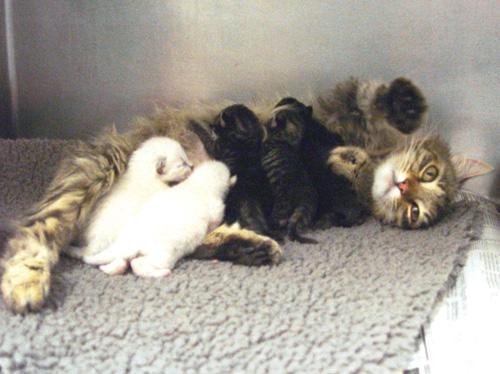You won’t find them on a corner holding a sign, but that doesn’t
mean they aren’t hungry. And, they won’t tell you they are
homeless, but that doesn’t mean they aren’t living on the
streets.
The (other) homeless population – abandoned pets and feral
animals that have never experienced a domesticated life – has
existed for as long as irresponsible pet owners have.
Unfortunately, a tough economy is only increasing the number of
dogs, cats, and even horses left to fend for themselves.
In 2009, the Sonoma Humane Society saw a 40-percent increase in
surrendered pets; 90-percent of that amount reportedly being the
result of pet owners either losing their jobs, their homes, or
undergoing other financial difficulties, according to Sonoma Humane
Society Public Relations Director, Angie Bonnert.
The humane society takes in animals surrendered by their owners,
strays that are abandoned or found on the street, and also animals
from other over-crowded shelters.
“The number one reason people gave for giving up their pets was
because they were moving. Unfortunately, a lot of places don’t take
pets,” Bonnert said. “This increase was definitely due to the
economy and the foreclosing housing crisis. People were coming in,
in tears, not wanting to give up their pets. They simply couldn’t
afford to keep them,” she said.
Take Blue, a 9-year-old female hound mix, for example. She was
adopted four years ago. “They loved her and she was a great part of
the family, but then they were forced to move and they had to give
her up again,” Bonnert said. “They were upset; the majority of the
people are.”
Godzilla’s family lost their home due to the economy, Bonnert
said of the 2-year-old male terrier mix. Same story goes for
Sparky, a 1-year-old terrier mix; Rocco, a 2-year-old purebred
boxer; Pan Pan, a 7-year-old female tabby cat; and Lily, a
3-year-old orange-colored feline, among others. And then there’s
Bailey, a 5-year-old domestic shorthair, who was surrendered when
her owner lost his job, and Tuxedo, a cat that was simply left
behind when his owners moved away.
“When an animal goes from a home situation to a shelter it’s
very traumatic ’cause they are going from being bonded with their
person or family, to having no one, so it’s a very frightening
experience,” Bonnert said. She said when she goes to outreach
events with dogs that have been abandoned or that are strays, she
senses they are searching for their owners. “When people walk by
the dogs look at them and put their noses in the air and
sniff.”
Over 5,400 animals came into the Sonoma County Animal Care and
Control between July 2008 and June 2009, according to its Director,
Amy Cooper. Nearly 4,000 of those animals were considered strays,
with slightly more cats than dogs. Over 1,000 animals were
surrendered to the local animal control during that same time
period. Statistics show that since that time (or between July 2009
and February 2010), there has only been about an 8 percent increase
in animal surrenders, which is a lot less than reported by the
local shelter. However, like the shelter, the increase in pet
surrenders is largely due to financial hardship. “I think we are
seeing not only an increase in surrenders, but also strays,” Cooper
said. “People are really struggling to keep things together right
now in their personal lives with job loss, home loss … and some
people have maintained a home and a job, but no longer have a
vehicle.”
Not only are more family pets landing in shelters, there is a
surplus of babies – as in kittens – brought in during the spring
and summer months. On average, between March and September, 400 to
500 kittens are seen at the local humane society, according to
Bonnert. “People need to spay and neuter their cats (and dogs),”
she said. “And, also look out for the neighborhood cats that people
put food out for, but don’t take responsibility for,” she said
referring to the fact that those cats, too, need to be “fixed” or
they will continue to do “what cats do; what comes natural to
them.”
According to statics provided by the Humane Society, one
un-spayed female dog, in one year, can produce up to 20 offspring;
one un-spayed female cat can produce up to 18 offspring. Six or
seven years later, that one un-spayed female dog – and now multiple
generations of its offspring – is responsible for up to 67,000
dogs; the one un-spayed female cat is responsible for up to 420,000
cats.
Forgotten Felines, a spay/neuter organization for feral and
stray cats, encourages people to trap feral cats, bring them to
their clinic, or a veterinarian to be spayed or neutered, and then
release them where they came from. “The whole point of this clinic
is the cats can go back to where they came from, and no longer
breed,” a receptionist named Stephanie said, referring to the feral
population. People are under the misconception that if there are
feral cats in an area where they don’t want them to be, that they
can simply “remove” the group of cats and that will be that. Not
the case, according to the receptionist who said removing the
colony will just create “a vacuum effect.”
There is a reason why the cats are there in the first place –
for example, someone in the neighborhood is feeding them – and if
they leave, new cats will move in. Cats are territorial and
generally won’t let newcomers in, she said. That’s why “trap,
neuter and release” has been proven to create a more stable colony,
she said. Forgotten Felines charges $30 to spay a feral cat, which
is considerably less expensive than going to a veterinarian. This
organization addresses the niche of cats that don’t belong to
anyone. To schedule an appointment with Forgotten Felines call
576-7999.
Apparently horses can be homeless too. Michael Murphy, founding
president of the Sonoma County Horse Council and the national
director of Back Country Horseman of America said with the economy
the way it is, more and more people are looking for homes for their
horse, or abandoning their horse because they can’t afford to feed
it. “The cost of hay has gone up, the cost of fuel has gone up …
You figure a dog eats maybe a couple cups of food a day; a horse
eats six tons of food a year,” Murphy said.









